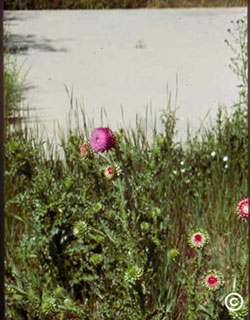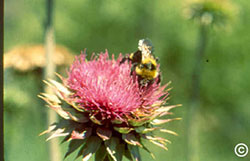
What is musk thistle?
Musk thistle is an ever-increasing problem in Colorado. It’s a noxious weed prevalent in open spaces, vacant lots, pastures, ditch banks and along roadsides. Musk thistle is a biennial, which means it lives only two years. In the first year, it germinates from seed and grows into a low-growing rosette of leaves. The leaves are very prickly-spiny, and often have a white margin. In the plant’s second growing season, it sends up multiple flowering stems. At this stage, the plant may grow two to six feet tall. As many as 100 flowers per plant develop in mid-summer through fall. Flowers are attractive purple-pink, about the size of a silver dollar. Just beneath the flowers are some very spiny bracts. After flowering and seed dispersal, the musk thistle plant dies.
How can I control the musk thistle in my yard?

The key to musk thistle control is to halt seed production. To accomplish this in the first year of the plant’s life, sever the root below ground with a shovel or hoe when the plant is in the rosette stage. This can also be accomplished in the second year by severing the root before flowers develop. Mowing musk thistle in its second year is effective if it’s done before any flowers mature. Herbicides are most effective when used on first year rosettes, especially in late summer or fall. Second-year plants that are developing flowering stems are much less susceptible to herbicides. Homeowners can use glyphosate or 2,4-D herbicides, when temperatures are 60 to 85 degrees Fahrenheit, and when winds are less than five miles per hour. Don’t allow spray to come in contact with any desirable vegetation. As with any pesticide, read herbicide label directions carefully and follow them explicitly.
Alternatively, an introduced insect called the musk thistle seed head weevil feeds on developing seeds and can reduce the number of viable seeds produced by fifty percent or more.
For more information, see the following Colorado State University Extension fact sheet(s).



